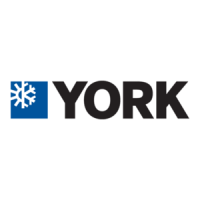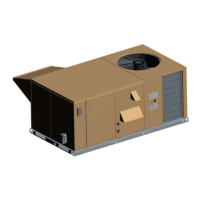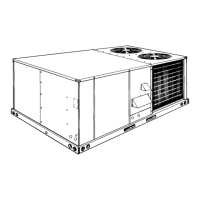Do you have a question about the York Sunline ZE Series and is the answer not in the manual?
Highlights signal words (DANGER, WARNING, CAUTION) and the safety alert symbol for potential injury.
General warnings about installation compliance, hazards, and proper operation.
System uses R-410A refrigerant; use compatible servicing equipment.
Inspect unit for transit damage; note any damage on carrier's freight bill.
Strict compliance with installation instructions and codes is mandatory for product installation.
Improper installation may create conditions causing personal injury or property damage.
Identifies the unit as a single package, R-410A unit, and explains model number components.
Specifies cooling capacity, heat type (electric/gas), and heat capacity in MBH or kW.
Details blower type, voltage, sensor options, service options, and outdoor air options.
Read instructions, ensure availability to consumer, and follow all safety warnings.
Lists codes and standards that must be followed for installation in the US and Canada.
Control boards operate down to 0°F for people cooling; consult for process cooling below 30°F.
Do not obstruct condenser air discharge, combustion air inlet, or vent outlets with structures or shrubs.
Instructions for safely moving and rigging the unit using lifting holes and spreader bars.
Specifies required clearances for proper operation and service according to codes.
Lists shipping and operating weights for common accessories.
Do not insert screws through casing when fastening ductwork; insulate outdoor ductwork.
Instructions for plumbing the condensate drain line, including trapping.
Information on scroll compressors, R-410A refrigerant, and POE oil handling.
Ensure panel latches are properly positioned for an airtight seal.
Requirements for field wiring, fuses, disconnects, grounding, and wire sizing.
Cautions regarding high-leg delta supply and water-proof connectors.
Transformer tap adjustment for different voltages for convenience outlet.
Guidelines for thermostat location, wire count, and maximum length.
Wiring diagram for single and three-phase power supply connections.
Detailed wiring diagram for Simplicity Lite control system.
Specifies minimum supply air CFM required for various electric heat kW options.
Provides gas heat capacity, input/output, rate, and temperature rise data.
Warnings about propane solvent properties and leak testing without flame.
Details gas supply line routing, typical arrangements, and piping recommendations.
Requirements for LP gas equipment, pressure, and piping.
Information on electric heater installation and power requirements.
Details on optional economizer, damper, and rain hood installation.
Guide to using the RRS Economizer controller's interface.
Setting the economizer minimum position for occupied mode.
Describes four types of free cooling: dry bulb, enthalpy, dual enthalpy, and auto.
Detailed sequence for cooling, including economizer and compressor staging.
Groups errors, limit switches, and low ambient cooling.
Economizer operation combined with power exhaust.
Discusses single/dual enthalpy, power exhaust, and damper controls.
Details the economizer board terminals and their functions.
Explains the status indicated by the LEDs on the economizer board.
How the IAQ sensor affects economizer operation and ventilation.
Correct phasing for motors and compressors; how to correct misphased connections.
How to correct blower performance data for altitude and temperature.
Walkthrough of the drive selection process using performance tables.
Table for selecting belt drive RPM based on unit size and motor/sheave settings.
Specifications for power exhaust motors, including voltage, HP, and electrical data.
Improper air quantity/static pressure adjustment can cause extensive system damage.
Combines additional static resistance values and pressure drop graph.
Detailed sequence for cooling, including economizer and compressor staging.
Groups errors, limit switches, and low ambient cooling.
Discusses single/dual enthalpy, power exhaust, and damper controls.
Specific modes for low ambient cooling operation.
Lists safety controls monitored by the unit control board.
Specifies temperature limit settings for various electric heat configurations.
Function of primary and auxiliary temperature limits in the furnace.
Limit control settings for single-stage and two-stage gas heat.
Essential checks and operations before starting the unit for cooling.
Essential checks and operations before starting the unit for gas heating.
Diagrams of typical single-stage and two-stage gas valves.
Visual guide and instructions for proper pilot and burner flame adjustment.
Instructions for checking or changing burners, pilot, or orifices.
Troubleshooting specific issues for Simplicity Lite control systems, including warnings.
Troubleshooting compressor not operating when M1 contactor is engaged.
Groups warnings and cautions related to gas heat troubleshooting.
How to interpret and troubleshoot flash codes from the control boards.
How pilot flame lockouts are handled and troubleshooting steps.
Step-by-step troubleshooting for common operational issues.
Table detailing Simplicity Lite flash codes and error descriptions.
Table detailing Ignition Control Board flash codes and error descriptions.
Details the Smart Equipment™™ Unit Control Board terminals and their functions.
Checklist for verifying installation and startup procedures.
Information regarding the warranty policy for the equipment.
Fields to be filled by the specifying engineer for proper application.
Checklist for general inspection points before operation.
Checklist for inspecting blower and drive components.
Checklist for verifying economizer settings and operation.
Table for recording electrical data during operation measurements.
Specific safety checks for the refrigerant system.
Verifying correct energization of heating/cooling stages based on demand.
Checking VFD modulation with duct pressure changes.
Combines final inspection and recording product deficiencies.
| Brand | York |
|---|---|
| Model | Sunline ZE Series |
| Category | Air Conditioner |
| Language | English |












